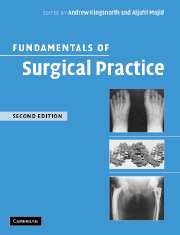Book contents
- Frontmatter
- Contents
- Preface
- Contributors
- 1 Preoperative management
- 2 Principles of anaesthesia
- 3 Postoperative management
- 4 Nutritional support
- 5 Surgical sepsis: prevention and therapy
- 6 Surgical techniques and technology
- 7 Trauma: general principles of management
- 8 Intensive care
- 9 Principles of cancer management
- 10 Ethics, legal aspects and assessment of effectiveness
- 11 Haemopoietic and lymphoreticular systems: anatomy, physiology and pathology
- 12 Upper gastrointestinal surgery
- 13 Lower gastrointestinal surgery
- 14 Hernia management
- 15 Vascular surgery
- 16 Endocrine surgery
- 17 The breast
- 18 Thoracic surgery
- 19 Genitourinary system
- 20 Head and neck
- 21 The central nervous system
- 22 Musculoskeletal system
- 23 Paediatric surgery
- Index
5 - Surgical sepsis: prevention and therapy
Published online by Cambridge University Press: 15 December 2009
- Frontmatter
- Contents
- Preface
- Contributors
- 1 Preoperative management
- 2 Principles of anaesthesia
- 3 Postoperative management
- 4 Nutritional support
- 5 Surgical sepsis: prevention and therapy
- 6 Surgical techniques and technology
- 7 Trauma: general principles of management
- 8 Intensive care
- 9 Principles of cancer management
- 10 Ethics, legal aspects and assessment of effectiveness
- 11 Haemopoietic and lymphoreticular systems: anatomy, physiology and pathology
- 12 Upper gastrointestinal surgery
- 13 Lower gastrointestinal surgery
- 14 Hernia management
- 15 Vascular surgery
- 16 Endocrine surgery
- 17 The breast
- 18 Thoracic surgery
- 19 Genitourinary system
- 20 Head and neck
- 21 The central nervous system
- 22 Musculoskeletal system
- 23 Paediatric surgery
- Index
Summary
Sepsis is defined as the development of a systemic inflammatory response syndrome (SIRS) as a result of an infective process. SIRS is characterized by two or more of the following conditions:
temperature greater than 38.4 ° C or below 35.6 ° C;
heart rate greater than 90 beats per minute;
respiratory rate greater than 20 per minute or PaCO2 less than 32mmHg;
white cell count greater than 12,000 cells per ml, or less than 4000 cells per ml or 10% immature (band) forms.
The above definitions of these different syndromes were made at a consensus conference jointly sponsored by the American College of Chest Physicians and the Society for Critical Care Medicine in 1991.
Severe sepsis may progress to multiple organ dysfunction syndrome (MODS), defined as organ dysfunction caused by systemic inflammation-induced damage in which homeostasis cannot be maintained without supportive measures. This may take the form of a primary insult (e.g. aspiration injury to the lung) or a secondary phenomenon (e.g. adult respiratory distress syndrome (ARDS) in severe pancreatitis). MODS was first described more than 20 years ago, following the observation that some patients succumbed to progressive organ system failure despite an initial phase of apparent stability. The phenomenon is a dynamic process which varies from patient to patient and even within the same patient at different times.
Despite better monitoring and supportive techniques in the intensive care unit (ICU), the mortality rate associated with sepsis remains high, especially when accompanied by shock and MODS.
- Type
- Chapter
- Information
- Fundamentals of Surgical Practice , pp. 58 - 70Publisher: Cambridge University PressPrint publication year: 2006



